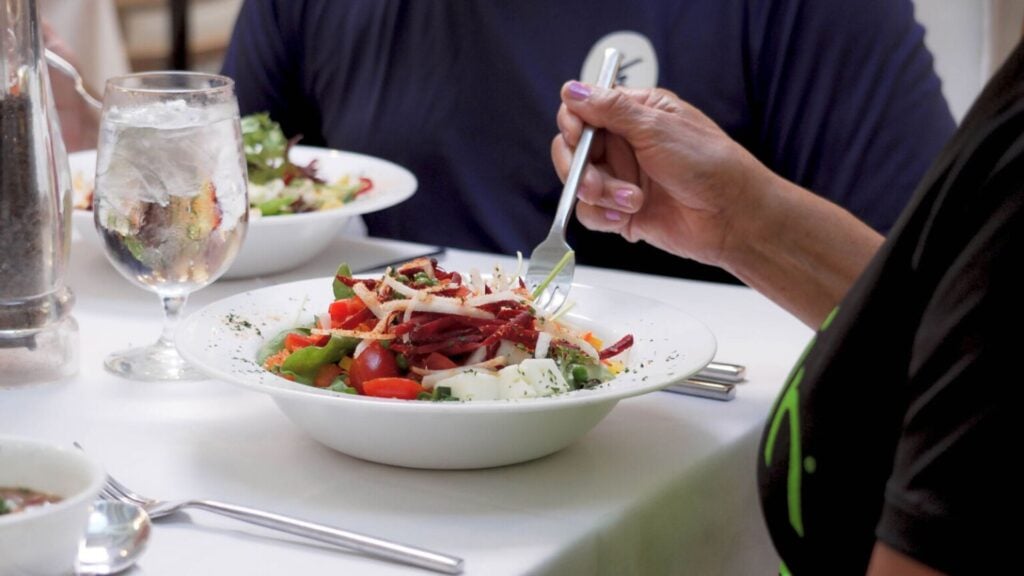Guide to the Best Diet for GLP-1 Meds

If you’re struggling with weight management, GLP-1 medications may be an option – but, what is the best diet to help you achieve sustainable weight loss?
Congratulations on taking proactive steps to live your healthiest life! Know what the best diet is for GLP-1 meds so you can achieve sustainable weight loss. This article will guide you through the science-backed dietary strategies experts suggest can help you maximize the effectiveness of your GLP-1 Meds and achieve sustainable weight loss.
What are GLP-1 Drugs?
GLP-1 (glucagon-like peptide-1) medications, also known as Ozempic or Wegovy (semaglutide), are drugs that mimic a hormone your bodies naturally make when you’re eating.
Is GLP-1 an Appetite Suppressant?
These hormones tell your body to start absorbing the food. GLP-1 reduces hunger and appetite.
The 3-fold increase in obesity (in 30 years) is driving research on appetite – GLP-1 has a key role.
GLP-1 and Weight Loss
GLP-1 makes you feel full and satiated – so, you eat less. As such, GLP-1 medications have become extremely popular tools for rapidly achieving weight loss.
For Type 2 diabetics, GLP-1 meds help them manage blood sugar levels.
Some users of GLP-1 Meds struggle with side effects. Learn ways to prevent GI side effects of GLP-1 drugs.
What to Eat While on GLP-1 Meds
While GLP-1 medications do the heavy lifting, chew on foods that improve your health. That’s how to optimize the effects of your GLP-1 medication – plus, it’s good for you!
Your diet plays a crucial role in whether you’ll:
- Maximize Weight Loss
- Reduce GI Side Effects
- Prevent GLP-1 Muscle Loss
- Achieve Sustainable Weight Loss
What’s the Best Diet for GLP-1 Meds?
Remember – your best diet may not be the same as the person sitting beside you. You need a customized diet that meets your unique health needs. Any resource that lists a series of meals you should eat on GLP-1 meds, forgot you’re unique. Use this science-backed guide to help you start to design the best diet for GLP-1 meds. If you’re struggling, don’t worry – this guide also has where to get help finding your best diet for GLP-1 meds.
The Best Foods to Eat and Foods to Avoid
Let’s start with the best foods to eat and those to avoid on GLP-1 medications:
1. BEST FOODS TO EAT ON GLP-1 MEDS
Eat Foods that Increase GLP-1 Levels Naturally
Eat this to feel full, say researchers. Every time you eat, you trigger the natural production of the appetite-suppressing GLP-1 hormones. But certain foods do a better job than others. Research says these foods naturally increase GLP-1 levels, and help you feel more satisfied:
- Fiber (whole grains, beans)
- Resveratrol (berries)
- Curcumin (curry powder)
- Cinnamon
- Protein (beans, fish, lentils)
Not surprisingly, foods found in the best weight loss diet naturally increase GLP-1 levels.
Fiber
A high-fiber diet enhances the effects of GLP-1 medications, according to research.
How? Microbes in your intestine break down fiber into smaller molecules, called short-chain fatty acids. These short-chain fatty acids then trigger the release of GLP-1 and peptide PYY that decrease your appetite.
But, not all fiber is equal.
To get this extra boost of satiation hormones, you’ll need to eat fiber the gut bacteria can digest, called fermentable fiber. These hunger-suppressing fibers can be found in these nutritious whole foods:
- Oats/Oatmeal
- Rye
- Whole wheat
- Beans
- Peas
- Lentils
- Apples
- Pears
Of note, since your body’s natural GLP-1 only lasts a few hours, eating a high-fiber diet doesn’t cause the same rapid weight loss as GLP-1 medications. GLP-1 meds persist for days. Hence, they have a greater impact on the brain, further reducing appetite and cravings, and causing very rapid weight loss.
Protein
Protein has a potent effect on your hunger, helping you feel fuller for longer.
Add protein to your diet to help your gut produce more GLP-1 naturally. As you design your best diet for GLP-1 meds, be sure to include lean protein sources, such as:
- Beans
- Chicken
- Fish
- Lentils
- Tofu
Protein can help counteract the muscle loss seen in GLP-1 use. This is important.
“With any rapid weight loss, there is not only fat loss but, also lean body mass loss, which is our muscle mass,” explains Dr. Maria Anton, Endocrinologist at The Pritikin Longevity Center in Miami, Florida.
Studies have found patients taking GLP-1, 35% of their weight loss was lean body mass (muscle). That’s a concern – “Lower lean body [muscle] mass is associated with a shorter lifespan.” notes Dr. Anton. “When we lose lean body mass, we lose overall strength which can increase the risk for falls and fractures as bone density can also be affected.”
Muscle is crucial for maintaining a healthy metabolism. Muscle helps you maintain blood sugar levels – and, is key in preventing insulin resistance. You want to keep your muscles!
“We want to maximize patient’s results in achieving their weight loss goals while preserving as much of that lean body mass as possible. The best ways are primarily through diet and exercise – this is what we really strive to help patients with when they arrive here at Pritikin.”
Pritikin experts are here to help.
2. FOODS TO AVOID ON GLP-1 MEDS
Fatty foods can hinder the appetite-suppressing effect of GLP-1 medications, according to studies. Yet, not all fats are created equal.
Saturated and Trans fats: Hinder weight loss efforts.
- Animal meats
- Eggs
- Dairy
- Processed foods
- Fried foods
Monounsaturated and polyunsaturated fats: Work synergistically with GLP-1 medications.
- Olives
- Avocados
- Nuts and seeds
Focus on sources of healthy fats (monounsaturated and polyunsaturated fats), and avoid those foods rich in saturated or trans fats.
Best Diet to Follow while on GLP-1 Drugs
According to research, here are the key elements of the best diet for GLP-1 medication users:
- Nourishing, water-filled foods (fruits and vegetables)
- Fiber-rich plants (whole grains, beans, lentils)
- Protein (fish, chicken, soybeans)
- Eat mindfully
- Listen to hunger cues
Establishing healthy eating habits is important as you strive to achieve sustainable weight loss. Even with GLP-1’s appetite-suppressing effects, mindful portion control remains important. Use smaller plates, focus on satiating foods, and listen to your body’s hunger cues.
This will also help you develop lifelong eating habits that support your ability to sustain your weight loss and prevent muscle loss with GLP-1 medications.
The Best Diet: The Pritikin Diet
The Pritikin Eating Plan aligns perfectly with the dietary principles that complement GLP-1 medications.
Focus on Whole, Unprocessed Foods: The Pritikin plan emphasizes whole, plant-based foods like fruits, vegetables, whole grains, and legumes. These fiber-rich foods trigger the natural release of GLP-1. Plus, water-rich foods truly help you feel full and satisfied.
Naturally Lower in Saturated Fat: The Pritikin plan minimizes saturated fat intake, which can hinder weight loss and contribute to other health concerns. This aligns with research suggesting that healthy fats can actually enhance GLP-1’s effects.
Promotes Sustainable Weight Loss: The Pritikin plan isn’t just about short-term weight loss – it’s about establishing healthy eating habits for life.
When you focus on delicious, whole foods you feel full and satisfied – this makes it easier to stick with long-term.
At Pritikin, you can design your best diet for GLP-1 medication use to achieve your weight loss goals.
“At Pritikin, you have the opportunity to really focus on yourself, to establish new habits that will help you achieve your long-term goals.”
During your stay, you have opportunities to speak with an Exercise Physiologist to develop your own effective exercise plan to maintain and increase your muscle mass.
If you have weight loss goals, we invite you to come visit Pritikin – where we can help you establish the best nutritional and exercise program to optimize your results.
Dr. Maria Anton
Come discover a sustainable lifestyle that supports your weight loss goals and overall health.

Get All the Details of a Stay at the Pritikin Center in Your Inbox
Scientific References:
- Effect of glucagon-like peptide-1 receptor agonists on glycemic control, and weight reduction in adults: a multivariate meta-analysis. PLoS One 2023; 18(1): e0278685.
- A combination of glucagon-like peptide-1 receptor agonist and dietary intervention could be a promising approach for obesity treatment. Front Endocrinol (Lausanne) 2021; 12: 748477.
- Clinical recommendations to manage gastrointestinal adverse events in patients treated with GLP-1 receptor agonists: a multidisciplinary expert consensus. J Clin Med 2023 Jan; 23(1): 145.
- Use of new diabetic medications. Centers for Disease Control and Prevention, 2023.
- Glucose tolerance, lipids and GLP-1 secretion in JCR:LA-cp rats fed a high protein fiber diet. Obesity 2012 Sept 6.
- GLP-1 agonists: diabetes drugs and weight loss. Mayo Clinic 2022.
- The role of peptide YY in appetite regulation and obesity. J Physiol 2009 Jan 1; 587(Pt1): 19-25.
- Short chain fatty acids: the messengers from down below. Front Neurosci 2023 July; 17.
- Nutritional modulation of endogenous glucagon-like peptide-1 secretion: a review. Nutr Metab (Lond) 2016; 13: 92.
- Improvement of glucose tolerance by food factors having glucagon-like peptide-1 releasing activity. Int J Mol Sci 2021 Jun; 22(12): 6623.
- Impact of skeletal muscle mass on metabolic health. Endocrinol Metab (Seoul) 2020 Mar; 35(1): 1-6.
- High-fat diet alters fluid intake without reducing sensitivity to glucagon-like peptide-1 receptor agonist effects. Physiol Behav 2020 Jul 1: 221: 112910.
- Glucagon receptor signaling and lipid metabolism. Front Physiol 2019 Apr 24; 10: 413.